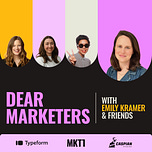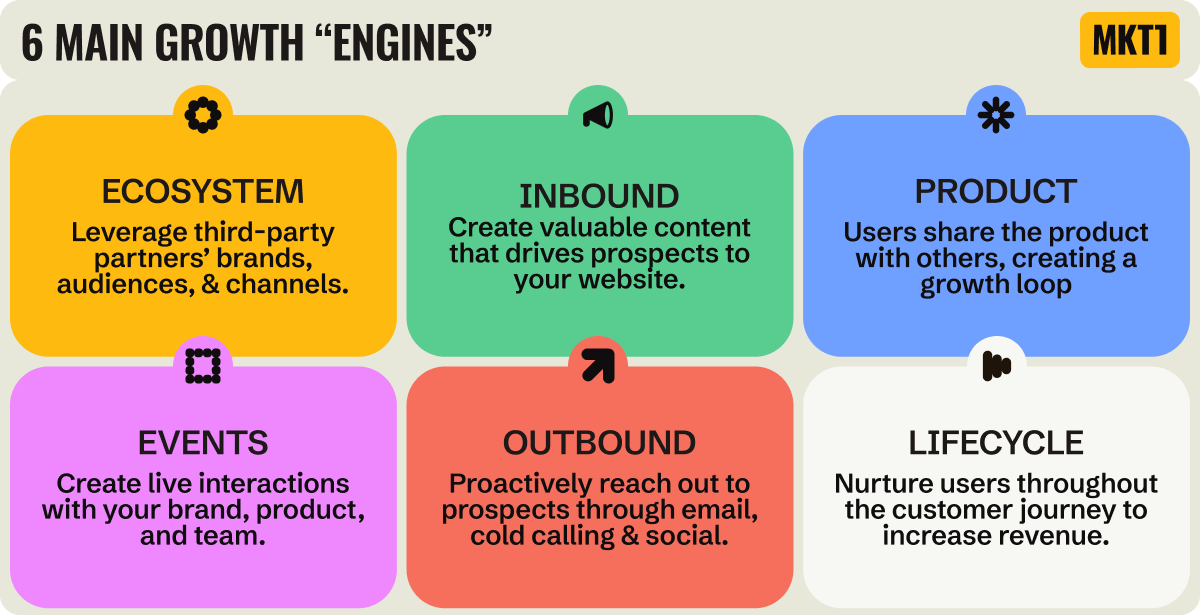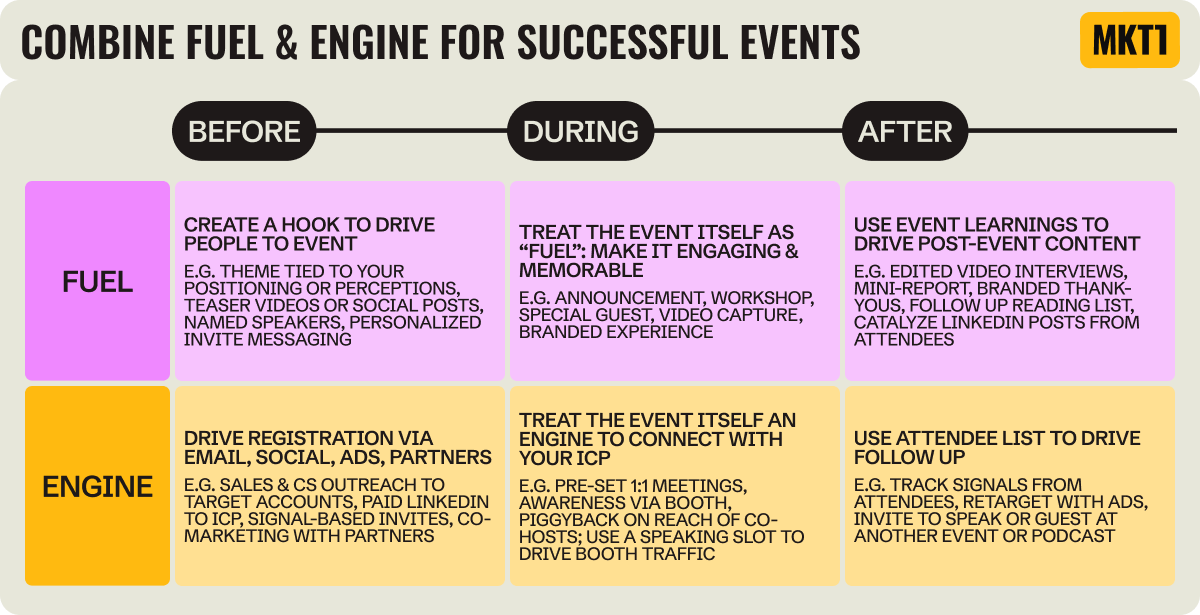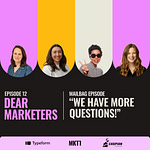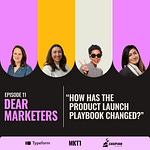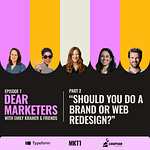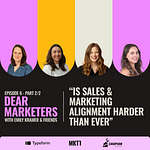🎙️ This free edition of MKT1 newsletter covers Season 1, Episode 10 of “Dear Marketers with Emily Kramer & Friends” podcast, brought to you by Typeform, Framer & Customer.io.
Listen or watch the podcast on Spotify, Apple Podcasts, or YouTube. Plus read the full newsletter below for an even deeper dive on the topic. The newsletter is meant to augment the podcast, not just recap it.
Today’s question:
“Dear marketers, I’m Daphne, the CMO of Voyantis. We’re really excited to keep investing in our event strategy, and I’d love to hear from you any new and innovative ways you’ve seen marketers leveraging events. And also how to think through balancing investing in third-party events versus hosting our own.”
– Daphne Hoppenot, CMO at Voyantis
Dear Daphne and Marketers, I’ve spent most of my career reluctant to build an IRL events strategy. I’ve historically only enjoyed 10–20% of events I’ve gone to and usually I just see marketing waste everywhere I look at large events. Instead of booths, I see dollars in trashcans. Instead of building relationships, I feel overwhelmed by sales pitches and fake interactions.
I’m a social person and I love marketers. But even curated dinners often run too long. I don’t think I’m alone. I at least know from recording this podcast episode that my co-hosts Devon & Grace are mostly on the same page.
But I’m starting to change my tune. Other channels are a bit shaky right now, and human connection is becoming highly valued. And in the years since I was in-house, I’ve worked with lots of startups who run events that help build community and relationships, amplify other messages and content, build long-term pipeline, and even drive short-term revenue. I’ve co-hosted a couple dinners and happy hours with brands I love, and I hope to do more of this soon. I’ve spoken inside booths as part of “in-booth programming” (which I’m a big fan of). And I’ve had some great times catching up with old friends and meeting new ones at micro-conferences.
That said, I still don’t think spending a massive portion of your marketing budget on an IRL event strategy is for everyone.
So when Daphne asked this episode’s question, I wasn’t even sure I wanted to do a podcast on the topic. But when I realized my co-hosts work at Mercury (who does amazing events and sponsorships) and Cocoon (HR tech knows how to conference), and that I had Kacie Jenkins (former SVP of Marketing at Sendoso, swag and gifting experts and a mainstay at marketing events) on speed dial, I decided I’d tackle the topic.
Here’s the big thing I want you to take away from listening to this podcast and reading this newsletter: Evaluating an events strategy is very similar to evaluating any marketing program. Don’t take it as a given that you need to prioritize events (or you risk doing some very expensive random acts of marketing). First you have to do the work of deciding if events are even right for your startup, before you can say “yes” or “no” to a specific event.
Luckily, there are some core MKT1 frameworks that can help with this. So let’s do it, let’s break down how to decide if IRL events are the right strategy for your company, and then how to choose the right ones and make them count.
In this newsletter & podcast episode:
Devon Watts (Head of Product Marketing and Partner Marketing at Mercury), Grace Erickson (VP of Revenue at Cocoon), with special guest Kacie Jenkins (SVP of Marketing at Sendoso until last month) and I discuss:
Should you even do events? How to evaluate if events are the right channel for your startup
How to choose the right events and make them count: How to build a rubric and evaluate different event types
How to avoid common event mistakes: What do my co-hosts think you should always avoid
Thanks to our Dear Marketers sponsors:
I vet each partner personally and these are genuine recommendations (even though yes, we do get paid for this).
Typeform: Typeform isn’t just for creating beautiful forms and collecting responses—you can summarize answers with AI, embed video, enrich data, route leads, and connect with 300+ tools. We use it at MKT1 and love it.
🎁 Offer: Use code MKT1 to get 20% off their annual growth plan.
—
Framer: A no-code website builder that feels like a design tool. With new AI layout generation, built-in analytics, and vector drawing, it’s even easier to build, test, and launch sites faster.
🎁 Offer: Framer will rebuild or migrate your site for free in 3 days. New and existing teams are eligible, just submit your brief at framer.com/switch.
—
Customer.io is used by Notion, Segment, and Buffer to message and engage with customers across email, push, in-app, SMS, Slack, and WhatsApp. It’s easy to plug in your data and trigger campaigns based on just about anything: profiled attributes, events, actions, you name it.
🎁 Offer: Get 2 months free of an annual Essentials plan when you request a trial through customer.io/mkt1.
Watch Episode 10 here, or keep reading for the full newsletter.
“An event is an experience, it's an extension of your brand. It's a chance to make really strong connections, build relationships, and represent your brand in a way that is much higher recall than any of the digital touchpoints you might be investing in.” – Kacie Jenkins, Former VP of Marketing at Sendoso in Episode 10
You can also listen to the podcast on Spotify or Apple Podcasts.
Part 1: How to decide if in-person events are the right strategy
“How do you decide if events are right for you? I think it’s not necessarily right for everyone. You don't necessarily need a Dreamforce. Not every startup needs to have an events motion. It is time-consuming. It is expensive. There’s a lot that can go wrong and usually, you don’t get a second chance after you’ve sponsored that thing for $50K.” – Emily Kramer (that’s me) in Episode 10
I never recommend throwing a new channel into your marketing strategy “just to test it out” if you don’t have a reason for prioritizing it. This is even more true with a high-cost channel like events.
So before you commit budget, time, and your sanity to an in-person event, here are a couple of frameworks you can use to decide if events are the right growth channel for your startup at all.
“You're not comparing events to each other; you’re comparing them to the other channels you can use. Events are an opportunity, you choose them because you can show off your product at an event, you can show off your brand, you can show off the people and the expertise that you have. But you better make sure that you can differentiate on at least one or two of those things. And if you don't have the bandwidth to to manage those logistics, to put the effort to make it work, it can be a big waste of money.” – Kramer in Episode 10
Evaluate channel/startup fit
Events are just one of the six highest-level growth engines your startup could be prioritizing. And they’re often the hardest and most expensive to execute well, even if you are doing them for the right reasons. To make the right call, you need to evaluate this channel against other channels, but also against your startup itself. Just because competitors or your favorite company do them, doesn’t mean you should too.
“It’s not… Am I sponsoring this trade show? Am I hosting this dinner? Am I putting on this event? Am I co-hosting with this partner? Those are not the questions. The question is: Is this a channel you are going to use? And for that, you have to compare it against your other channels.” – Kramer in Episode 10
I wrote a newsletter on channel/startup fit last year. It goes into great detail on how to decide which channels are best for your startup, but here’s an events-focused rundown:
1. Start by understanding your audience
Get clear on your ICP definition(s) and your TAM (total addressable market), but go a step beyond. You need to deeply understand your audience’s behavior to determine the right channel mix.
Ask these questions to determine if events are a good fit:
Likelihood to attend: Do they like attending conferences? Are they overwhelmed with event invites? Are they more likely to attend virtual events or IRL due to location, role, time constraints?
Community-oriented: Do they value peer-to-peer learning? Are they active in specific communities or industry networks—and do those organizations host events?
Buying process alignment: Are in-person touchpoints important in their buying process? Who is most likely to attend an event, the decision-maker or the product end user? Does this align with the outcome you want?
“To come up with the channels that are a fit for your startup, you need to go back and say, ‘What does our product marketing research tell us? Who is our audience? What market are we in? What product is this? How does this fit with your go-to-market motion? How do people buy this?’” – Kramer in Episode 10
2. Match channels to your GTM motion
Align channels with your business model. That includes your GTM motion (e.g. product-led, sales-led, hybrid), pricing model, average contract value, lifetime value, etc.
Sponsoring events and a big events budget tends to work best with sales-led, high-touch motions. If you have fast sales cycles and lower ACVs, product-led growth or inbound may be a better early bet. That said, this isn’t a hard and fast rule. Even startups with low ACVs are leaning into community and events to augment their PLG strategy (like Clay!). This is why you need to factor in audience behavior as well.
3. Play to your strengths
You need to recognize your marketing advantages and how you can win in your market. This sometimes means zigging when competitors zag.
Use channels that amplify the strengths that you already have. If your advantages include things like a brand that truly stands out, a big partner network (to co-host with), high audience demand for educational content and workshops, a founder that loves to be on stage, etc. events may be a good fit.
4. You need the right “fuel” to fit the “engines” you select
Engines don’t work without fuel, so if you don’t have the right content and creative to fit a channel you’ve selected, that engine isn’t going to work.
If you have no ability to staff an event, don’t do events. If there’s no reason to attend an event and then to engage at the event, don’t do it. If you have no channels or process to follow up, don’t do it. More on this framework in the next section.
5. Don’t try all channels at once, and re-evaluate your channel mix regularly
One of the most common marketing mistakes is spreading yourself too thin and doing random acts of marketing (R.A.M), as I always say. You can’t check boxes, you need to go for impact.
So pick one or two channels and run real campaigns using these channels. And remember, channel-startup fit isn’t static. As your team, budget, audience, or the channels themselves evolve, so should your strategy. All of a sudden, events might shift from a no-go to a key driver of your strategy.
As you scale, you can layer in and combine multiple channels. 1+1 can equal 3, or 1+1+1 can equal 5. For example, events, ecosystem, and outbound are a very effective channel “throuple.” Find a partner to co-host with, then do outbound to prospects together to increase reach and attendance.
Approach events as campaigns, that combine fuel and engine
“Events really need to be approached as a campaign strategy, right? You’re executing with many touch points over a prolonged period of time. Identify a central asset that everything else either leads to or comes from.” – Grace Erickson in Episode 10
Events are a difficult thing to categorize.
In my brain, most marketing tactics fall neatly into one of three buckets: fuel, engine, or campaign. But events are an exception: they’re all three. And that’s exactly why they’re powerful when done well and why they can be expensive flops when done poorly—and why they scare me a little.
Events are an engine: They help you directly reach and build relationships with your audience.
Events are also fuel: The experience itself is a type of content (just like a piece of long-form content or a podcast); and they help you generate even more content before and after the event.
They’re also a type of campaign, which we’ll get to in a second.
You might not think this matters (unless you write a marketing newsletter that attempts to organize how marketing works into coherent frameworks), but recognizing this is the key to a successful event with positive ROI.
A quick refresher on the fuel & engine framework
Skip this if you’re a MKT1 super fan
“Your engine and fuel need to be made for each other and made for your audience. And the same is true for an event itself. Great events are both fuel and engine” – Kramer in Episode 10
I talk about this all the time, but if you're new to MKT1, here’s an explanation of one of our most popular frameworks: fuel & engine.
Fuel is what you create: your content, creative, and messaging.
Engine is how you distribute that fuel: your channels, targeting, and workflows.
Balance both: It’s the only way to build a scalable, sustainable marketing machine.
Fuel & engine misalignment: Too much fuel with no distribution? Wasted effort. Too much engine with no fuel? Spammy and not valuable.
Align with your audience: Your fuel and engine not only need to match each other, but they need to match your audience.
If you can’t build a campaign around your event, (probably) don’t do it
At MKT1, we define campaigns as marketing initiatives that combine both fuel and engine. They’re typically focused on a specific audience segment (or set of segments) and anchored around a theme. Product launches, demand gen plays, ABM initiatives, and yes, events, are all campaigns.
That’s good news: You don’t need a different playbook for each. You just need to plan cross-functionally, align fuel and engine, and start with a GACCS brief (more on that below).
“It’s not just the event itself. It’s before, during, and after. You have to be ready to carry momentum beyond the booth.” – Devon Watts in Episode 10
To make events really work, you need to treat them as campaigns that span before, during, and after the event itself.
Before: Create content that hooks people in (through a strong theme, teaser assets, or personalized invites) and activate the right engines to drive attendance (email, social, ads, partner outreach).
During: The experience should serve as both engine (e.g. 1:1 meetings, booth traffic, speaking slots) and fuel (e.g. content capture, branded experiences, memorable moments).
After: Don’t waste the momentum. Use the attendee list to drive your post-event “engine”: retarget and follow up. Use insights to drive net-new content creation and repurpose content from the event into video clips, customer stories, and social posts. This is how you extend ROI well beyond the event itself.
Quick tip: Pairing an event with a launch—whether it’s a product announcement, new report, or even a rebrand—can significantly increase impact for both the event and the launch.
Part 2: Choosing the right IRL events
Find events with the right mix of ICP coverage & composition
“If it’s low composition and low coverage, you’re in trouble.” – Kramer in Episode 10
Even if an event seems like a good fit for your product, it only works if the right people are in the room. And it’s not enough to say “my ICP is there.” If you think like that you’ll be sponsoring every event sales or your founders recommend to you. You’ll spend your whole budget on events and have no content to fuel them, no engine to follow up on them, and no team to execute and show up! This is where the idea of coverage and composition comes in.
The concepts of coverage and composition are borrowed from media planning/ad buying (my first job!) and are adapted here to help you evaluate if your events have the right audience and enough of your audience to generate ROI.
Coverage = What % of your TAM (total addressable market) will be at the event
→ How much of your target market can you reach by showing up?
High coverage means a meaningful portion of your TAM will be in one place, which is great for awareness.
You’ll typically find high coverage at large industry conferences for your audience like SaaStr, Dreamforce, CES, Money 20/20, Transform.
High coverage means you had lower control over who’s in the room. That’s why many companies choose to run a side event (e.g. a happy hour during the conference) to show up without going all in and wasting dollars on people who don’t care about what you are doing in the least.
Composition = What % of event attendees are in your TAM
→ What % of the people at the event are actually your target buyers?
High composition means minimal waste; most attendees are in your ICP. That’s ideal for deeper conversations and conversion.
You get high composition when you control the invite list, like at a curated dinner, a micro-conference, or a co-hosted workshop with a partner who shares your audience.
These events won’t get you massive reach, but they can drive real pipeline and build long-term relationships.
Use this lens to decide which events to sponsor, show up to, or host yourself.
If you’re at an event with low coverage and low composition, you’re probably wasting budget.
If coverage is high but composition is low, you might have trouble getting the message across to the right people or waste money on visitors that just don’t matter.
If composition is high, but coverage is low, make sure you are spending an appropriate amount per attendee and that you’ll have a chance to really engage with the people there.
Depending on your goals for events, you can decide what’s more important, or do different events to hit on different goals.
“I'm part of a lot of communities, so is my team. And we'll do just a word of mouth scan if it's an event we haven't done before. And then I'll also just look up everything I can find within communities that people have said about that event.” - Kacie Jenkins in Episode 10
Choose the right type of event, and make them count
“Events aren’t just trade shows. It could be dinners, terrarium-making, whatever. But the point is: How does your audience prefer to do business?” - Grace Erickson in Episode 10
We’ve narrowed our podcast conversation and this newsletter down to just in-person events, not virtual events. But even within IRL events you’ve got a lot of options.
Here’s a breakdown of how I’d approach deciding between types. You can try multiple event types, but each muscle takes a while to build, so proceed with caution.
Here are some examples of each event type:
Hosted: Dinner or roundtable, roadshow or multi-city tour; field event or product workshop; side event/party tied to a major industry event; in-office meetup or open house; user conference (note: these are very expensive, and I’d give a different set of smiley faces in the diagram!)
Co-hosted: Joint dinner or happy hour with a complementary product, industry organization (like MKT1!), or VC; panel or fireside chat with a community; or startup crawl.
3rd-party event, sponsored and/or booth: Trade show booth (e.g., SaaStr, Dreamforce); conference sponsorship with branding or attendee list access (not recommended); sponsored/pay-to-play speaking slot or branded session; meeting room on site; branded lounge, coffee bar, etc.
3rd-party event, speaker or attendee: Guest who speaks on panel or gives a keynote; attending to network or learn; scheduling meetings on conference floor; scoping the scene for next year; etc.
“At a smaller company, co-hosted smaller events were the best move. It’s a low-lift way to tap into each other’s audiences—and a great pipeline accelerator.” – Devon Watts in Episode 10
Start with a rubric and brief
Kacie in Episode 10: “We actually don't really do event [sponsorships] anymore unless someone is giving a talk or a workshop in tandem.”
Kramer: “So you're sponsoring it, but then there's a plus.”
Kacie: “Yeah there's a plus and that plus will drive traffic back to the booth. Because people will come out of that talk or workshop saying, ‘Oh wow, I wanna talk to you about this.’”
Before you green-light any event, especially expensive sponsorships of third-party conferences or partner events, you need two things: a rubric to evaluate the opportunity and a (GACCS) brief to plan it effectively. Think of the rubric as the gate (should we do this?) and the brief as the plan (how will we do this well?).
Yes, we have templates and interactive tools to help you make both—paid subscribers only.
First: Use a rubric to assess if you should do the event at all
Create a simple system to evaluate event opportunities. That way, when someone outside of marketing asks you to do an event, you have a clear, objective way to evaluate it and report back.
You can use similar criteria to what we used in the smiley face matrix: strategic fit, ICP fit (including coverage and composition), fuel and engine fit, quality of interaction, and cost/ROI potential. This gives you a repeatable way to say no (or yes) to trade show invites, expensive sponsorships, or co-hosting asks. It keeps decisions grounded in strategy, not opinions and also gives you language to push back when needed: “We reviewed this against our rubric—it’s low-fit, high-cost, and not a priority right now.”
For more on managing requests, check out episode 1 of the pod.
Then: If the rubric says “yes,” write a G.A.C.C.S. brief
Like almost every project in marketing, you need to start with a G.A.C.C.S. (goals, audience, creative, channels, stakeholders) brief, customized for events.
Here’s what to include, or find our GACCS template for paid subscribers here.
Goals: Why are you doing this event? Define the primary outcome you want from the event: Long-term awareness, short-term pipeline gen, customer expansion or loyalty, etc.
Examples: Drive 10 net-new meetings with Tier 1 accounts, deepen relationships with partners, or capture 5 high-quality video testimonials
Audience: Who are you targeting at this event? Get specific about ICP segment, account tier, persona, and funnel/lifecycle stage. Break down composition and coverage too.
Examples: High coverage, low composition of tier 1 enterprise prospects; medium coverage, medium composition of existing customers
Creative: What’s the “fuel” strategy? What’s the primary message or other content you are promoting? Define how experience and brand come to life, everything from theme, message, design, content, swag, and moments you want to create.
Examples: Re-used booth design from x conference, custom dinner menus, branded gift bags, on-site video capture
Channels: What’s the “engine” strategy? How are you driving attendance? How are you handling follow-up?
Examples: AE email outreach to drive attendance; LinkedIn DMs to drive meetings at event, SDR post-event signal-based campaign, follow-up dinner to build on relationships made
Stakeholders: Who is involved and responsible? List internal and external collaborators, include who is doing work before, during, and after the event.
Examples: DRI is field marketer, AEs own invites; Emily, Grace, and Devon rotate in booth, Kacie guest speaker at event
NEW: We built an interactive event rubric and GACCS template in Lovable for paid subscribers
We decided just making Google Docs templates felt old-fashioned. So we vibe coded some new tools you can use—they are a work in progress, so let us know what you think. Find them under Episode 10 in our tools and template library.
If you’re going to do events, do them right
Devon in Episode 10: “There are definitely event format limitations. Events are a constricting channel in some ways. Also, because there are events for every industry and every world you can think of, even the original things don't feel original anymore because once you've seen it 10 times, that's old now. So it's hard to find something that really feels unique and then isn't gonna just get copied.
Kramer: “So what’s next? Just add value. Have an expert there, do an audit of the product, show them how they would get this set up, make it a workshop, put talks in it.”
Even if you do decide events are the right growth engine—and even if you choose the right type—you can still get it wrong. Any event you do should feel like an extension of your brand. Few companies actually follow through on this well.
Remember: If you can’t differentiate at your event, you probably shouldn’t do it. If it seems like a generic opportunity where you can’t stand out, you probably can’t. If your event ideas feel too cheesy or overthought, don’t do it.
I wrote about this on LinkedIn about a year ago, specifically for booths:
Mistakes to avoid
“I feel so strongly about this: I don't think that you should be doing events if your idea of a good event is to hire a person who is either disconnected from your company and your brand to plan and staff it or to hire the most junior person to manage the logistics of it.” – Kacie Jenkins, former SVP of Marketing at Sendoso
We talk more about what makes for great and not-so-great event experiences in the podcast, but here’s what we’ve seen go sideways most often, according to Devon, Grace, and Kacie:
❌ Mistake: Using the wrong resources to manage events
Events work best when the people running them deeply understand your audience, product, and brand. That doesn’t mean your PMM needs to do it all. Yes, you can hire some support for the logistics, but the person from your company showing up should be able to speak to the audience in a natural and informative way.
✅ This usually means you send an in-house marketer and/or product expert in addition to sales to larger events.
❌ Mistake: More sales than marketing
Relatedly, if events come off like a sales pitch, no one is going to want to be there. Use your marketing team to figure out how to create value and brand moments. The best event teams act like campaign owners, not just calendar fillers. They know how to get people to the event, make them excited to be there, and make it matter. Sales can be involved, but balance this out.
✅ We also recommend setting up “events in a box” templates to help you scale smaller events:
For things like dinners run by sales or partnerships, where it’s not realistic for marketing, product, or the co-founders to attend every one, this can really help.
“Events in a box” are repeatable, co-branded event templates for your sales team or partnerships team to make it easy for them to spin up things that are great.
You can include things like thought-starter questions, dinner menu templates, slides, available swag, a post-event follow-up template for reps or CSMs.
“Sales teams want to do every event—but you can’t just send AEs and expect magic to happen.” – Grace Erickson in Episode 10
❌ Mistake: Giving attendees the event “ick”
Here are some things that give us bad vibes at event, you’ll want to avoid things your specific audience might find cringe:
Over-eager sales people in the booth and/or no value add from going to the booth
Swag, games, or themes that don’t connect back to your brand. At least try to make a pun or something…
Celebrity speakers that have zero connection to your space. Nobody is going to buy your product just because you got Ryan Reynolds on stage
Dinners that drag on, with no meaningful conversation
Meetups that make solo attendees feel scared to network (my worst nightmare)
✅ Plan the experience and treat it as fuel!
“I really like an interactive booth, but I'm actively anti-basketball hoop, for instance. Unless you're selling in-office games to increase employee engagement, then basketball hoop for sure. But just to lure people in, if you're casting your top of funnel that wide that people are coming in wanting nothing to do with you only wanting to shoot your basketball, and then you're relying on whoever's working the booth to somehow seamlessly transition from the hoop to your product, don’t do it.” – Grace Erickson, game-hater, in Episode 10
More in the podcast…
Listen to this episode to learn…
If Devon actually shared a stage with Oprah
How Grace does a live survey during events, and uses it to create an exclusive, follow-up benchmark
How many miles Kacie Jenkins flew in the last year to attend, host, and speak at marketing events
What else gives us the conference “ick”
More advice from an events lover (Kacie) and 3 recovering event skeptics (me, Grace, and Devon)
Whether we should bring back the “era of the mascot:”
Check out the full podcast episode on Spotify, Apple Podcasts, or YouTube.
Templates & resources for events:
Available in our template library for paid subscribers only »
Event rubric in Google Docs and an interactive rubric in Lovable.
GACCS brief in Google Docs and a new interactive brief in Lovable.
Channel selection guide in Sheets
Marketing requests form example in Typeform
Also don’t miss our brand-new GTM tools library, available to all subscribers for a limited time.
More from MKT1 & Dear Marketers
🙏 Thanks again to our sponsors: Typeform, Framer & Customer.io.
⭐ Please rate us or subscribe wherever you get your podcasts: Spotify, Apple Podcasts, or YouTube. Season 1 is almost over (Episode 12 is our last), so convince us do a Season 2.
⁉️ Want to ask a question in a future episode? We have a Typeform for that.
🧑🚀 Job board: Jobs from the MKT1 community. Want to post on the job board? It’s free for paid subscribers!
🎙️ Next podcast: Dear Marketers Episode 11 on product launches (I finally am covering this topic!)
📰 Next “deep dive” newsletter: The MKT1 B2B marketing field guide


